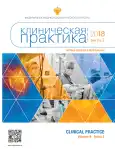Possibilities of modern neuroimaging techniques in the diagnostics and neuromonitoring of the recovery process in patients after ischemic stroke
- Authors: Ekusheva E.V.1, Kiparisova E.S.1, Kurzanceva O.O.1, Smirnova O.A.1
-
Affiliations:
- Institute of Advanced Training of the FMBA of Russia
- Issue: Vol 9, No 2 (2018)
- Pages: 4-11
- Section: Original Study Articles
- URL: https://journals.rcsi.science/clinpractice/article/view/10618
- DOI: https://doi.org/10.17816/clinpract0924-11
- ID: 10618
Cite item
Full Text
Abstract
Ischemic stroke is still leading in terms of primary disability caused by residual neurologic de-fect in the majority of patients. Persistent motor disorders are observed even after timely and ade-quately carried out rehabilitation measures. The article discusses the possibilities of modern instru-mental technologies for diagnostics and further monitoring of the process of restoration of post-stroke deficit, which is based on the phenomenon of neuroplasticity.
Full Text
##article.viewOnOriginalSite##About the authors
E. V. Ekusheva
Institute of Advanced Training of the FMBA of Russia
Author for correspondence.
Email: ekushevaev@mail.ru
д.м.н., профессор кафедры нервных болезней
Russian Federation, MoscowE. S. Kiparisova
Institute of Advanced Training of the FMBA of Russia
Email: kiparisova-es@yandex.ru
д.м.н., профессор кафедры нервных болезней
Russian Federation, MoscowO. O. Kurzanceva
Institute of Advanced Training of the FMBA of Russia
Email: olgakurzan@yandex.ru
к.м.н., доцент кафедры лучевой диагностики и маммологии
Russian Federation, MoscowO. A. Smirnova
Institute of Advanced Training of the FMBA of Russia
Email: olgakurzan@yandex.ru
заведующая учебной частью кафедры лучевой диагностики и маммологии
Russian Federation, MoscowReferences
- Бархатов Ю.Д., Кадыков А.С. Прогностические факторы восстановления нарушенных в результате ишемического инсульта двигательных функций // Анналы клинической и экспериментальной неврологии. 2017. № 11(1). С. 80–89.
- Дамулин И.В., Екушева Е.В. Деменция вследствие поражения мелких церебральных сосудов: патогенез, клиника, лечение // Неврология, нейропсихиатрия, психосоматика. 2014. № 4. С. 94–100.
- Дамулин И.В., Екушева Е.В. Инсульт и нейропластичность // Журнал неврологии и психиатрии имени С.С. Корсакова. 2014. № 114(8). С. 136–142.
- Добрынина Л.А. Возможности функциональной и структурной нейровизуализации в изучении восстановления двигательных функций после ишемического инсульта // Анналы клинической и экспериментальной неврологии. 2011. № 5(3). С. 53–56.
- Екушева Е.В. Сенсомоторная интеграция при поражении центральной нервной системы: клинические и патогенетические аспекты: Автореф. дисс. ... д-ра мед. наук. М.: РНИМУ им. Н.И. Пирогова, 2016.
- Ишемический инсульт и транзиторная ишемическая атака у взрослых: Клинические рекомендации Министерства здравоохранения Российской Федерации. М., 2015.
- Пирадов М.А., Танашян М.М., Кротенкова М.В. и др. Передовые технологии нейровизуализации // Анналы клинической и экспериментальной неврологии. 2015. № 9(4). С. 11–17.
- Скворцова В.И. Реперфузионная терапия ишемического инсульта // Медицинский консилиум. 2004. № 6(8). С. 610–614.
- Труфанов Г.Е. Лучевая диагностика. М.: ГЭОТАР-Медиа, 2011.
- Basser P.J., Pierpaoli C. Microstructural and physiological features of tissues elucidated by quantitative-diffusion-tensor MRI // Journal Magnetic Resonance. 1996. Vol. 111. P. 209–219.
- Di Pino G., Pellegrino G., Assenza G. et al. Modulation of brain plasticity in stroke: A novel model for neurorehabilitation // Nature Reviews Neurology. 2014. Vol. 10. No. 10. P. 597–608.
- EEG-fMRI. Physiological basis, technique, and applications / Ed. by A. Schmuel. Berlin; Heidelberg: Springer-Verlag, 2010.
- Hara Y. Brain plasticity and rehabilitation in stroke // Journal of Nippon Medical School. 2015. Vol. 82. No. 1. P. 4–13.
- Jang S.H. The role of the corticospinal tract in motor recovery in patients with a stroke: A review // NeuroRehabilitation. 2009. Vol. 24. No. 3. P. 285–290.
- Johansson B.B. Brain plasticity in health and disease // The Keio Journal of Medicine. 2004. Vol. 53. No. 4. P. 231–246.
- Lee J.S., Han M.K., Kim S.H. et al. Fiber tracking by diffusion tensor imaging in corticospinal tract stroke: Topographical correlation with clinical symptoms // NeuroImage. 2005. Vol. 26. P. 771–776.
- Leukel C., Taube W., Beck S., Schubert M. Pathway-specific plasticity in the human spinal cord // European Journal of Neuroscience. 2012. Vol. 35. No. 10. P. 1622–1629.
- McDonnell M., Koblar S., Ward N.S. et al. An investigation of cortical neuroplasticity following stroke in adults: Is there evidence for a critical window for rehabilitation // BMC Neurology. 2015. Vol. 109. No. 15.
- Moller A.R. Neural plastisity and disorders of the nervous system. Cambridge: Cambridge University Press, 2006.
- Moser E., Meyerspeer M., Fischmeister F. et al. Windows on the human body – in vivo high-field magnetic resonance research and applications in medicine and psychology // Sensors (Basel, Switzerland). 2010. Vol. 10. No. 6. P. 5724–5757.
- Murphy T.H., Corbett D. Plasticity during stroke recovery: From synapse to behavior // Nature Reviews Neuroscience. 2009. No. 10. P. 861–872.
- Rossini P.M., Burke D., Chen R. et al. Non-invasive electrical and magnetic stimulation of the brain, spinal cord, roots and peripheral nerves: Basic principles and procedures for routine clinical and research application. An updated report from an I.F.C.N. Committee // Clinical Neurophysiology. 2015. Vol. 126. No. 6. P. 1071–1107.
- Warach S., Dashe J.F., Edelman R.R. Clinical outcome in ischemic stroke predicted by early diffusion weighted and perfusion magnetic resonance imaging: A preliminary analysis // The Journal of Cerebral Blood Flow & Metabolism. 1996. Vol. 16. P. 53–59.
- Winnubst J., Cheyne J.E., Niculescu D., Lohmann C. Spontaneous activity drives local synaptic plasticity in vivo // Neuron. 2015. Vol. 87. No. 2. P. 399–410.
- Wissel J., Olver J., Stibrant Sunnerhagen K. Navigating the poststroke continuum of care // Journal of Stroke Cerebrovascular Disease. 2013. Vol. 22. No. 1. P. 1.
- Zorowitz R., Brainin M. Advances in brain recovery and rehabilitation 2010 // Stroke. 2011. Vol. 42. No. 2. P. 294–297.
Supplementary files











